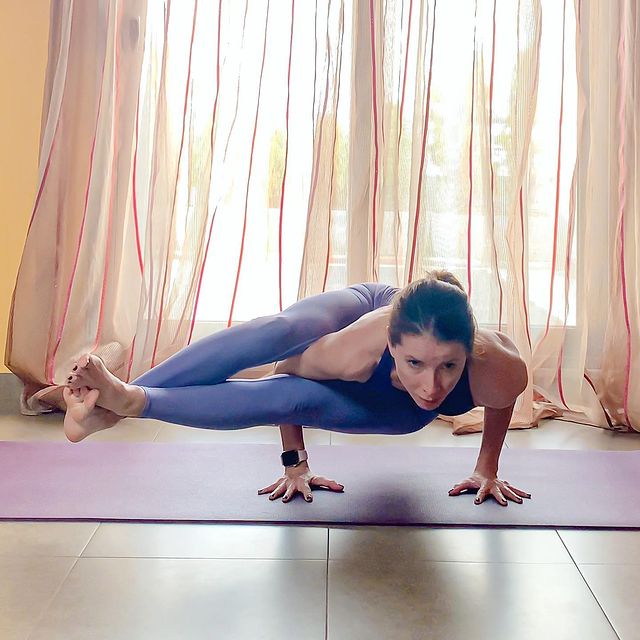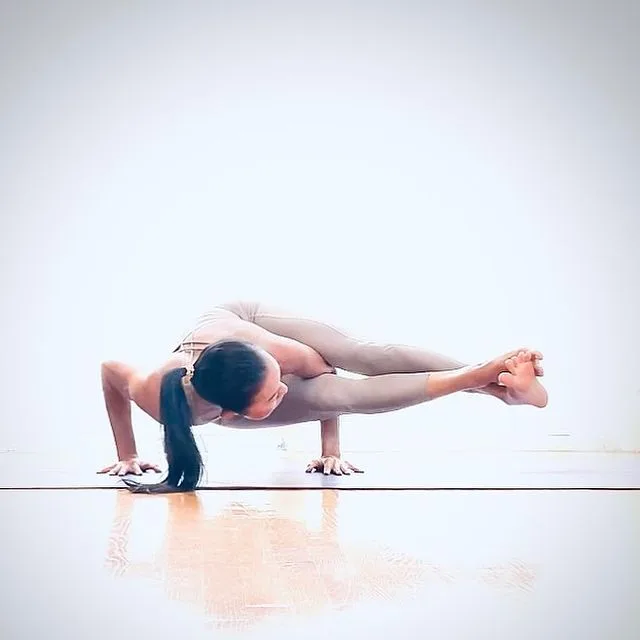The Eight-Angle Pose, also known as Astavakrasana, focuses on building strength in your arms and wrists. This is a great position once you’ve mastered the Standing Forward Bend Pose, Bound Angle Pose, Four Limbed Staff Pose, and Extended Side Angle Pose.
Information
| Known as: | Eight-Angle Pose, Astavakrasana, Ashtavakrasana |
| Sanskrit name: | अष्टावक्रासन |
| IAST: | Aṣṭāvakrāsana |
| Pronunciation: | uh-shtuh-vuh-KRAHS-uh-nuh |
| Level: | Advanced |
| Type: | Arm balance, forward bend, twist |
| Total time: | 30 to 60 seconds |
| Drishti: | Forward; Toes/feet (Padayoragrai or Padayoragre) |
| Chakra: | Manipura Chakra, Swadhisthana Chakra |
| Focus: | Arms |
| Indication: | Abdominal organs |
| Counterpose: | Child’s Pose (Balasana) |
| Preparatory poses: | Uttanasana, Kapotasana, Chaturanga Dandasana, Baddha Konasana, Utthita Parsva Konasana, Eka Pada Utkatasana, Upavistha Konasana |
| Follow-up poses: | Bhujapidasana (Shoulder pressing posture), Dwi Pada Bhujasana |
| Contraindications: | Wrist, elbow, or shoulder injury, High Blood Pressure, Heart Ailments, Pregnant Women |
Meaning + Origin
The Astavakrasana is derived from the Sanskrit name, which is made up of three words — Asta (or ashta) + Vakra + Asana:
- “Asta or ashta” = “eight”
- “Vakra” = “bent or curved”
- “Asana” = “pose or posture”
Astavakrasana is achieved by bending your body in eight different areas or angles; One in your chest, one in your neck, one in your each hand, one in your each leg and each knee, hence its name Astavakrasana or Eight-Angle Pose.
According to Hindu mythology, there was a sage who was the spiritual teacher of King Janak of Mithila. When the sage was in his mother’s womb, he learned everything about the Vedas from his father.
One day his father, Kahoda was reciting the Vedas and tried many mistakes in doing so. As for his mistakes, the unborn sage could not help but laugh. This enraged his father due to which he had to curse his son that he would be born with crippled body in eight regions.
Thus, when he was born he had a folded body around his chest, neck, legs, arms and knees. For this he was named Ashtavakra. The Ashtavakrasana is also obtained by bending the body like his body, hence it is named after him.
Sage Ashtavakra was crippled but led a successful spiritual life and guided King Janak during his reign. His life is a perfect example that physical disability can be ignored if you have strong will and spirit.
The pose, despite being a challenging pose, provides similar benefits to the practitioner by engaging the soul to achieve mental stability. This yoga posture also allows the yogi to appreciate his inner strength.
Benefits of Eight-Angle Pose (Astavakrasana)
Common yoga exercises of advanced pose are done to improve the strength, flexibility and stamina of the body. But the same advanced postures can be practiced to bring balance and stability not only with the physical body, but also with the mental.
The pose stimulates the Manipura and Swadhisthana Chakras. The activation of these chakras helps to foster confidence and creative skills. It energizes the body and increases the standard of living.
However, the physical and mental benefits derived from the practice of Ashtavakrasana (Eight-Angle Pose) are listed below:
- Physical Benefits:
- Strengthens wrists, elbows, arms and shoulders, chest, hips, knees, ankles and spine
- Stretches the arm muscles, diaphragm, back muscles, abdominal, core muscles, psoas, pelvic floor muscles, gluteus, hamstrings, quadriceps and calves
- Builds overall stamina
- Massages the internal organs and toned the abdomen
- Improves sexual health, thereby improving the efficiency of the reproductive system
- Mental Benefits:
- Reduces stress
- Improves focus
- Increased mental stability
Eight-Angle Pose (Astavakrasana) Practice Guide
Eight-Angle Pose (Astavakrasana) combines the components of a twist and an arm balance, as in Bhujapidasana (Shoulder-pressing pose), the place where the feet are wrapped around the hands, that place forms the bandha.
Look for ways to increase the twist in this pose. For example, notice how your leg on top of the hand rests its foot under the opposite ankle. Pull up with the top leg to draw your pelvis and lower body deeper into the twist. Then, with the other hand, press down with your arm and straighten your elbow of the free arm (the arm that doesn’t have legs around it). It rotates your shoulders and upper body away from your pelvis and deepens into your twist.
Look at the muscles that generate these movements and specifically engage them. For example, contract your hip abductors on the upper leg to pull your lower body deeper into the twist. Activate the triceps of the arm you’re trying to straighten to twist the shoulders and chest. Learn how to isolate these muscles and see how engaging them improves posture. Conversely, see how this and other yoga postures can be used to increase your awareness of specific muscle groups.
In addition to the twist, a lock is formed where the foot wraps around the arm. Trying to straighten the elbow, squeeze the hand from the thighs. Then try to stretch the knees. Watch how the lower leg presses into the forearm, straightening the elbow, creating a counterforce for the triceps. These opposing actions form a bond and stabilize the currency. This shifts the effort of the posture to the bones and ligaments rather than the muscles.
Step-by-step Instruction to Eight-Angle Pose (Astavakrasana)

Prepare your torso with Marichyasana III (Marichi’s pose III). This not only stretches your torso, but also lengthens the abductor muscles on the sides of your hips (tensor fascia lata and gluteus medius). Use poses such as the bent-knee version of Supta Padangusthasana (Reclining hand-to-big-toe Pose) to stretch your gluteus maximus and hamstrings. This allows you to raise your leg over your shoulder in the final pose. You can also use Kurmasana (Turtle Pose).
Instructions
- Begin by standing in Mountain Pose. Stand tall and straight with the feet slightly further than hip width apart. Establish a solid relationship with the ground by changing the weight distribution so that it is divided equally between the base of the big toes, the base of the little toes, and both the left and right sides of the heel.
- While exhaling, stand and bend forward. Place the hands on the ground beside the feet.
- Bend the knees slightly and place the right hand inside and then behind the right leg. Press the hand into the ground beside the right foot. Slowly move the right hand behind the right knee until the knee is over and behind the right shoulder.
- Support the shoulder with the knee and take your left ankle to hook your left ankle over your right. Angle the body slightly to the left, transferring most of the weight to the left hand.
- Slowly raise the feet off the ground. Exhale and bend your elbows. Tilt your torso forward and let it come down until it is parallel to the ground. Simultaneously, let the knees straighten as you extend your now-straight legs to the right, parallel to the ground.
- Press the upper right hand between your thighs. Using pressure in the upper arm, rotate your body to the left, keeping your elbows tightly in. Watch the ground while doing this.
- Stay in this position for 30-60 seconds.
- To release yourself from this position, slowly straighten the arms, raise the torso, bend the knees, separate the ankles and set the feet back on the ground. Step back into a standing forward bend position and rest for a few minutes.
- Repeat this process on the left side.
Step-by-step Anatomy Engaging Techniques
Step-1
Flex your hips using your psoas and its synergists—your adductors longus and brevis and pectinus. Your tensor fascia lata and gluteus minimus also contribute to this action. Bend your trunk to the side by engaging your rectus abdominis and oblique abdominals.
Step-2
Contract your quadriceps to attempt to straighten your knees. When your legs are crossed, straightening your knees, your legs squeeze your arms. It stabilizes the pose.
Step-3
- Cross your ankles and reverse them by engaging your peroneus longus and brevis muscles on the sides of your lower legs. It locks your ankles together.
- Then, while straightening your knees, try to separate your legs.
- Pull strongly on your upper side leg to engage your gluteus medius and tensor fascia lata more firmly on this side. This draws your legs deeper into the twist, rotating your pelvis in the opposite direction to your shoulders.
Step-4
- Press your mound into the mat at the base of your index finger by contracting your pronators teres and quadratus.
- Stabilize your elbows by engaging your triceps.
- Keeping your elbows close to the torso, use your pectoralis major to press the body upward.
- Your anterior deltoids assist in lifting your trunk.
- Look at your serratus anterior pulling your scapula forward and tethering them to the thorax.
- These are the same muscles that engage in Chaturanga Dandasana to lift your body off the floor.
Step-5
- Contract your rhomboids to draw your shoulder blades toward the midline.
- Engage your infraspinatus, teres minor and posterior deltoids to externally rotate your shoulders. It works in conjunction with the muscles that articulate your forearms. The cue to engage these muscles is to press the mound of your index finger into the mat. The net effect is a coiled force from your shoulders to your hands that tightens your elbow ligaments (ligamentotaxis).
- Engage your upper-side erector spinae and quadratus lumborum to slightly arch your back and laterally flex your trunk.
- On the upper side, your internal oblique contributes to lateral flexion. Your external oblique rotates your shoulder toward your opposite hip. Feel and visualize these muscles contracting in the posture.
Precautions and contraindications
Astavakrasana (Eight-Angle Pose) is an advanced arm balancing pose with a lateral twist. Individuals should keep certain precautions and contraindications in mind while practicing Ashtavakrasana (Eight-Angle Pose) to avoid injury. Given below are the precautions and contraindications of this yoga pose:
1. High blood pressure and heart disease
Since breathing can be restricted when trying to keep the body forward and in balance, individuals with high blood pressure, heart disease and dizziness are advised to avoid this yoga pose.
2. Back Pain or Herniated Disc
Individuals with back pain problems or individuals with a herniated disc (any part of the spine) should avoid practicing this yoga pose.
3. Injury and surgery
With the practice of Ashtavakrasana (Eight-Angle Pose), a lot of stretch is felt in all the joints and muscles of the body. Therefore, if any part of the body is injured, or is recovering from a recent surgery, they should avoid practicing this mudra. Injuries to the shoulders, arms, wrists, neck, hips, knees, lower back, ankles, feet and pelvis are all contraindications, so should be avoided. Individuals with carpal tunnel syndrome should also avoid practicing this pose.
4. Pregnant women
Pregnant women should avoid the practice of this yoga pose as a lot of pressure is felt in the abdominal and pelvic region, causing obstruction in breathing.















